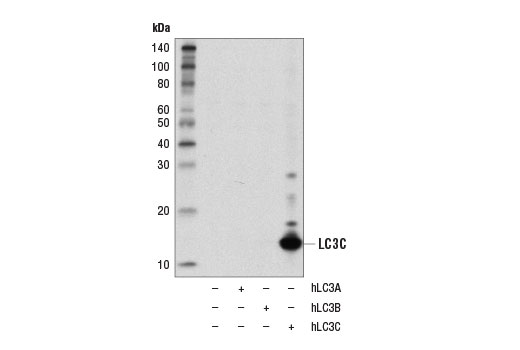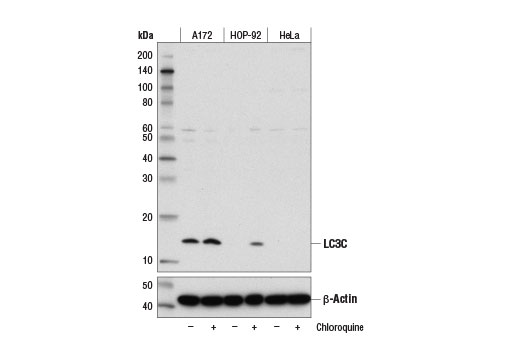Autophagy is a catabolic process for the autophagosomic-lysosomal degradation of bulk cytoplasmic contents (1,2). Autophagy is generally activated by conditions of nutrient deprivation, but it has also been associated with a number of physiological processes including development, differentiation, neurodegenerative diseases, infection, and cancer (3). Autophagy marker Light Chain 3 (LC3) was originally identified as a subunit of microtubule-associated proteins 1A and 1B (termed MAP1LC3) (4) and subsequently found to contain similarity to the yeast protein Apg8/Aut7/Cvt5 critical for autophagy (5). Three human LC3 isoforms (LC3A, LC3B, and LC3C) undergo posttranslational modifications during autophagy (6-9). Cleavage of LC3 at the carboxy terminus immediately following synthesis yields the cytosolic LC3-I form. During autophagy, LC3-I is converted to LC3-II through lipidation by a ubiquitin-like system involving Atg7 and Atg3 that allows for LC3 to become associated with autophagic vesicles (6-10). The presence of LC3 in autophagosomes and the conversion of LC3 to the lower migrating form, LC3-II, have been used as indicators of autophagy (11).In general, expression of LC3C protein is lower than the other LC3 isoforms, with the highest LC3C expression observed in placenta, lung, and ovary (7).
1.Reggiori, F. and Klionsky, D.J. (2002) Eukaryot. Cell 1, 11-21.
2.Codogno, P. and Meijer, A.J. (2005) Cell Death Differ. 12 Suppl 2, 1509-18.
3.Levine, B. and Yuan, J. (2005) J. Clin. Invest. 115, 2679-88.
4.Mann, S.S. and Hammarback, J.A. (1994) J. Biol. Chem. 269, 11492-97.
5.Lang, T. et al. (1998) EMBO J. 17, 3597-607.
6.Kabeya, Y. et al. (2000) EMBO J. 19, 5720-28.
7.He, H. et al. (2003) J. Biol. Chem. 278, 29278-87.
8.Tanida, I. et al. (2004) J. Biol. Chem. 279, 47704-10.
9.Wu, J. et al. (2006) Biochem. Biophys. Res. Commun. 339, 437-42.
10.Ichimura, Y. et al. (2000) Nature 408, 488-92.
11.Kabeya, Y. et al. (2004) J. Cell Sci. 117, 2805-12.
 全部商品分类
全部商品分类























 用小程序,查商品更便捷
用小程序,查商品更便捷




